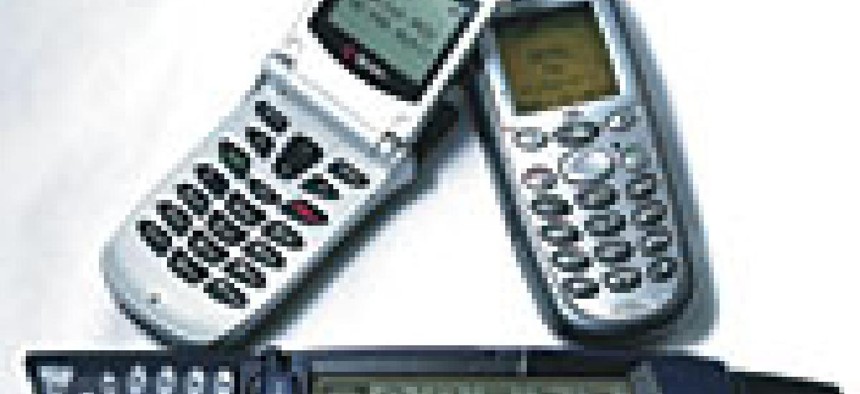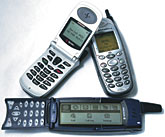A cell phone is simply an advanced two-way radio, and about 40 percent of the U.S. population now carries one. As the wireless spectrum gets more crowded, special phone features and even basic carrier services sometimes don't work.The GCN Lab tested eight wireless phones as well as five carrier services, whose quality matters more than the phone features. Four of the carriers offer plans in the General Services Administration's Wireless Store, at .The reason why service varies from carrier to carrier is that each carrier is assigned about 800 frequencies in any one city. The carrier divides the geography into 10-square-mile hexagons known as cells. In an analog system, each carrier typically has 395 voice channels, with 42 frequencies reserved as control channels.Any one cell has 56 analog voice channels available. If 56 people are already talking within the cell where you happen to be, you won't get a channel until someone hangs up or you move into a new cell. That's why, during a crisis such as the Sept. 11 terrorist attacks, wireless networks became overloaded when everyone tried to call at once.Digital wireless service permits more channels per cell'about 168. Because the towers transmit at low power, several cells can share the same frequency so long as they are not adjacent.Some advanced systems allow more users per cell, but this requires an infrastructure investment that carriers are not making in the current economic climate.Service problems often arise on the borders between cells. A cell phone, when powered, constantly broadcasts its position back to its carrier. When you get a call, the carrier's mobile telephone switching office (MTSO) checks a database to see which cell your phone is currently in. The MTSO then assigns a free frequency pair for your phone and the incoming call to use.If you're talking as you reach the edge of your current cell, the signal strength monitored by the MTSO falls off rapidly. At the same time, a base station within the adjacent cell will detect your phone's incoming frequency. The two base stations coordinate through the MTSO and at some point automatically switch your call into the new cell. If this handoff works properly, you never notice. If it doesn't, your call gets dropped.In the lab's tests, the with Nextel Communications service married its hardware the most successfully to software applications.Nextel's digital wireless calls were clear. The service plans seem a bit more expensive than competitors', but that is offset somewhat by the fact that Nextel bills calls by the second. Most carriers charge by the minute for even one extra second.Nextel uses a standard called GSM, or global system for mobile communications, to access its integrated Digital Enhanced Network (iDEN). GSM's advantage over the competing Interim Standard 136 of the Telecommunications Industry Association is that GSM encrypts signals'a plus for government users.The Nextel service, however, does not use the Narrowband Advanced Mobile Phone Service protocol, NAMPS, to access analog networks. If you happen to be outside a Nextel area, your phone service won't roam because it can't kick over to analog. Nextel has extensive coverage, however. I used the i85s without any dropped calls in Dallas, Detroit, Las Vegas, Los Angeles and St. Louis.The i85s phone was the first to run Java applets, which means individual users can customize it by uploading or deleting programs. My test unit had several custom applets including an automatic expense report recorder, a calculator, a stair-height calculator for construction work and a Sega game.The i85s was one of the few phones in this review with truly functional Web browsing, thanks to the large screen. About eight lines of text appeared in normal mode, or about six lines in a bigger font size.The phone was relatively safe to use in so-called car mode, by pressing only one button to accept a call. Its speakerphone automatically activated for hands-free talking. The i85s earned a Reviewer's Choice designation for combining solid hardware, intelligent software and an extensive digital network.The was tiny'less than 3 inches long when folded, although it opened outward to normal phone size. It wasn't the smallest phone in the review, but it was the smallest with reliable digital service, through Sprint PCS.Sprint's Code Division Multiple Access (CDMA) system sends digitized voice signals over the entire available bandwidth of a cell. Multiple calls can be overlaid, because each data bit has a unique sequence code that the MTSO can recombine.This sophisticated handling means that almost all calls go through; not one call dropped during our tests. The phone worked in dead zones where no other phone did'a testament to the reach of the Sprint PCS network.The phone had other good features such as voice-activated dialing and limited Internet access. It did not come standard with hands-free dialing, however, or even a belt clip. But it earned a Reviewer's Choice designation for compact size and reliable service.The , a personal digital assistant bundled with a phone, unfolded to reveal an LCD the full length of the phone.With a stylus, the phone worked much like a PDA to schedule, send and receive e-mail, and synchronize with standard desktop programs such as Microsoft Outlook. Tapping on a contact's information dialed the number automatically.The test phone's VoiceStream Wireless service operated via GSM in the 900-MHz and 1.9-GHz frequency ranges. Only a few times during peak hours did a call fail to go through, probably because of the dual frequency bands.The Smartphone's two main drawbacks were price and ruggedness. Users who already have PDAs wouldn't be willing to pay so much more for a phone. And the large LCD screen with flip-down dialing buttons made the unit more fragile than most. The phone earned a Reviewer's Choice designation for its novelty and functionality.The would look right at home in a bag of spy gadgets. It was the smallest phone in the review'just two inches when folded and light at only 3.9 ounces.An exterior display showed who was calling. There were more than 30 ring and vibration combinations, from Beethoven to jazz.The buttons were easy to push, and both inside and outer displays had a pleasing blue backlight readable in total darkness. The numbers on the inner display were large and legible.The 60c would have gotten an A grade except for problems with the Verizon Wireless service, which used CDMA as well as analog service, neither of which seemed to work very well in GCN's area. During the evening rush hour, calls repeatedly were cut off. One 10-minute call disconnected three times.Though all calls initially connected, mysterious drops were common. When the phone was working well'90 percent of the time'calls were as clear as on a land line. Because calls repeatedly dropped out in certain areas, the likely culprit was poor MTSO performance at switching calls between cells.Despite that annoyance, it would be hard to find a more compact, easily portable digital phone.The Motorola 120c was about standard size for a non-flip phone and had a tapered shape convenient for holding. Its service was also Verizon Wireless, but the 120c used trimode CDMA for transmissions. It supported CDMA in both 800-MHz and 1.9-GHz bands. It could automatically switch bands or drop to analog as needed during a call. The 120c proved stable during testing, without any dropped calls. Signal and call quality were excellent.A few nice extras included a hands-free headphone that doubled as speakers and volume controls for the built-in radio. In radio mode, the phone could scan for new stations and set favorites via the dialing buttons. If a call came in, pressing one button could switch from music to talk. Battery life was excellent, averaging 72 hours of standby.On the negative side, the screen was difficult to read, especially for text Web surfing. And the screen was recessed so deeply that shadows blocked out text under most lighting.The , a high-quality entry-level phone, had a fairly rugged antenna and was about standard size but heavier than the other phones.The test unit used AT&T Digital PCS, which searches multiple bandwidths to find a signal. Overall, the signal quality and strength were excellent around Washington, but outside the area, signal strength sometimes died out. Calls weren't dropped, however.Inside the city, talking in elevators, parking garages and large buildings was no problem.The display was small, showing only three or four lines of text, which made Internet browsing difficult.The had standard features that worked well with the reliable AT&T Digital PCS service.Nokia promoted the 5165 as simple to learn, but we didn't find it any easier than the other phones. The e-mail feature was difficult to use because long addresses, such as jbreeden@postnewsweektech.com, overflowed the limited screen area. Messages longer than 150 characters were also cut off.The phone could send brief text messages to other Nokia users, but the interface was so awkward that just calling would be easier.On the plus side, voice service was excellent, and calls sounded clear without background static. Even during peak hours, most calls went through.The had some high-end features in a low-end phone. It did almost everything that the slightly more expensive 5165 could do, such as text messaging. The 3285 could even access the Web but was handicapped by its small screen. The tall, thin letters detracted from readability.Service on the Verizon network proved a problem for the 3285. It never managed to pick up a digital signal anywhere in the Washington area and defaulted to roaming for the entire test period. Nokia's Web site did not show service plan information for any major cities, so we suspect the 3285 has not yet been widely distributed. On the plus side, the roaming signal was strong.
The three Reviewer's Choice wireless phones came from Samsung (top left), Motorola (top right) and Ericsson. Each used a different digital service and had good voice reliability as well as Internet access.







